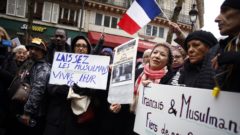Why would we blame writers for what they write instead of the readers who take offense at what they read?
Unholy War
In 1908, a 13-year-old boy named Khorloogiin Dugar entered a Buddhist monastery in Achit Beysiyn, Mongolia, a region under the control of the Qing Dynasty. He took the religious name “Choibalsan” and began studying to be a lama, but spirituality, it would seem, was not his forte. In 1913, the boy fled from the monastery and found his way into the Russian education system. He marinated in Marxist ideology, made Russian friends, and, following the October Revolution, returned to his native Mongolia (now an independent Buddhist khanate) to help spread communism there. Mongolia was ultimately established as a supine Soviet surrogate, with Choibalsan ideally situated to befriend Stalin and rise through the ranks. In 1936, he became the Minister of Internal Affairs, then Prime Minister.
Dictatorial power enabled him to pursue a cherished goal: the eradication of his childhood faith in Mongolia. This turned out to be a formidable job, since Buddhism was deeply embedded in Mongolian culture. At the outset of the twentieth century, roughly a third of adult Mongolian men were lamas of some grade, while monasteries had enormous significance as cultural and economic centers, the mainstays of both spirituality and education. At first, the state tried to quash the influence of the lamas through government propaganda, heavy taxation of monasteries, and stringent restrictions on speech and religious education. However, Buddhist influence remained strong, and a frustrated Choibalsan resorted to an approach he openly described as “liquidation.” Of more than 82,000 lamas connected to monasteries in 1937, about 18,000 were murdered by the state, while the rest mostly fled or went to ground. Monasteries were razed, along with their sacred objects and religious texts, while the remaining few were re-outfitted for secular purposes. Buddhist rituals and festivals were banned, and dissenters rapidly executed. In the space of just a few years, a thriving Buddhist culture was all but eradicated.
Though I have a long-standing interest in religious persecution, I knew nothing about the destruction of Mongolian Buddhism until I read Thomas Albert Howard’s Broken Altars: Secularist Violence in Modern History. The book chronicles the violence perpetrated against religious communities by repressive secularist regimes of the twentieth century. It’s truly astonishing how much there is to tell. Even well-informed readers should brace themselves; they’re liable to feel shell-shocked by the final page.
There may also be a sense of indignation. Why don’t we talk about this more? The breadth and severity of religious persecution in the twentieth century are simply stunning. It spans decades and continents, and may afflict Muslims, Jews, Christians, Buddhists, any faith at all. Nevertheless, within the Western political-theoretical conversation, it still seems to be widely assumed that secularism is the solution to wanton violence. We still speak, for instance, as if it were a commonplace that the Middle Ages were a particularly repressive and intolerant time. But set against the backdrop of twentieth-century secularism, even the Spanish Inquisition looks like a minor dust-up. It killed a few thousand people for their beliefs; murderous secular regimes killed tens of millions.
Though critical of ideological secularism, Howard is no enemy of liberalism. He acknowledges the brutality of Europe’s Wars of Religion and understands that theocracy has some obvious shortcomings. But he also wants readers to recognize that godless government has a very ugly rap sheet of its own. Any credible theory of liberalism needs to account for this in a very deliberate way.
Flavors of Secularism
Secularism comes in many forms, and Howard repeatedly emphasizes that they should not be conflated. He names three different forms of secularism. “Passive secularism” is essentially disestablishment combined with real protections for religious liberty. Howard offers the United States Constitution (understood in light of the Founders’ original intent) as a paradigmatic example, but also suggests (more controversially) that the French Revolution began in this “passive” mode before taking a “Jacobin turn” and moving in a more aggressive and antitraditional direction. Further along the scale, “combative secularism” is “anticlerical and progressive in orientation” and seeks to undermine religious influence while still showing some level of tolerance for more culturally embedded manifestations of faith. Finally, “eliminationist secularism” seeks to erase religious influence entirely, smothering religious belief and practice, torching buildings and sacred texts, and persecuting both clergy and ordinary believers.
In Albania, where religion was essentially banned outright, pilgrims would sneak onto holy sites at night and leave simple wooden crosses. The state bulldozed these repeatedly but the crosses kept appearing, until authorities finally gave up.
Howard uses this spectrum as a framing device for the book, though his attention is certainly concentrated on the repressive end. He devotes one chapter to combative secularism, discussing three main case studies: post-Revolution Mexico, pre-fascist Spain, and interwar Turkey. This is meant as a lead-in to more severe forms of religious repression, though it’s really not at all mild. In Mexico and Spain, churches and relics were burned or hacked to pieces. Large numbers of priests, many of them simple pastors with no involvement in politics, were arrested and murdered. Howard describes Spanish revolutionaries playing soccer with the skulls of once-revered saints, while Mexican villagers were coerced into swapping Christian feasts for sham secular substitutes such as the “Feast of the Banana Flower.”
In Turkey, Mustafa Kemal Atatürk is often remembered for his genocidal pogroms against Christians, especially Armenians, which evidenced a ruthlessness that Adolf Hitler cited as inspirational. Howard, however, focuses more on Kemal’s systematic suppression of Islam, which was less bloodthirsty but far more consequential in its impact on the faith itself. In the historic heart of the recently-collapsed Ottoman Empire, he abolished the fourteenth-century-old Islamic caliphate, jettisoned the traditional Muslim calendar, suppressed the Qur’an in its original Arabic, banned religious education and clothing, and aggressively propagandized young Turks in the truth faith of secularism. Howard concludes this chapter with the very interesting suggestion that Kemal’s repressive methods laid down regrettable patterns both for later secular regimes in the Islamic World (such as Saddam Hussein’s Ba’ath Party) and for reactionary Islamist movements. The deep animosity has never really ebbed. One wonders: could things have been different for the Islamic world had a less repressive leader risen to power after the war?
Moving on to full-bore “eliminationist secularism,” Howard devotes two chapters to the Soviet Union, with one focused on post-Revolution Russia and the other on Eastern Europe after World War II. It’s fair to say that the Soviets saw Christianity (the dominant faith in the region) as their most formidable religious opponent, but Howard also discusses brutal Soviet violence against Muslims, Jews, and Buddhists, all of whom were coerced, arrested, or simply murdered in large numbers by Soviet authorities seeking to eliminate any competitors to the totalitarian state.
Pogroms against religion eased somewhat in Russia itself during and after World War II, as Stalin explored the upsides to a more caesaro-papist approach to religion. This had its own fallout: Howard relates the sad story of how the Orthodox Church was, to a depressing extent, co-opted by Soviet leaders, used to cannibalize other Christian (and especially Catholic) churches. Also, for newly Soviet countries like Romania, Poland, and Albania, the post-war period was a particularly bleak hour, when thriving Christian cultures were brutally and systematically suppressed by the communists. Howard tells of Romanian priests and pastors forced to torture one another, churches converted into “anti-religion” museums, and pervasive surveillance meant to root out thought criminals. This chapter, central to Howard’s scholarly areas of expertise, also contains some of the most moving stories of quiet popular-level resistance. In Albania, where religion was essentially banned outright, pilgrims would sneak onto holy sites at night and leave simple wooden crosses. The state bulldozed these repeatedly but the crosses kept appearing, until authorities finally gave up.
A thick chapter on “Red Asia” covers Mongolia, China, and Cambodia under the Khmer Rouge. Now Buddhism takes center stage, along with Taoism, as temples are burned and lamas murdered in large numbers in China, Cambodia, Mongolia, and Tibet. (Christians and Muslims were also targeted, and even Confucianism has sometimes been viewed as a threat, though at other times it has been embraced as a kind of statist secular philosophy.) The persecution was especially intense during the Cultural Revolution, though Howard notes that Chinese persecution of traditional religion began even before Mao’s communists took charge. Even under the Qing dynasty, many Chinese elites saw the abandonment of religion as a necessary precondition to embracing Western progress. Though this is not a major point of emphasis for Howard, it does recur throughout the book. Brutal repression is often motivated by a belief that traditional faith impedes progress, as refracted through the lens of Western political ideologies.
A brief conclusion reiterates the importance of distinguishing grades of secularism, before returning to the central question: “What accounts for the persistence in the West of the commonplace that religion is inherently violent and secularism the appropriate, liberating solution?” He notes too the asymmetry in Western attitudes towards Nazism, which is reviled, and secular totalitarianism of a more socialist stripe.
Not one to push a heavy-handed agenda, Howard largely leaves this question for readers to ponder. My own reflections suggest two possible explanations. At first glance, they seem to be deeply in tension, but in fact, I suspect there is some truth in each.
Restraining Caesar
It could be that Westerners pay too little attention to repressive secularism because the most noteworthy cases are so far outside our experience that they simply don’t seem applicable to our own situation. Or, it could be that we turn a blind eye to repressive secularism because it is frighteningly familiar, and we don’t want to look in that mirror.
The repressive regimes described in Broken Altars span different continents and cultures. Several different faiths find themselves in the crosshairs at various points. With the exception of Spain, though, Howard’s central examples mostly don’t take place in developed Western nations. Most of them are communist, though Mexico and Turkey are exceptions (along with pre-communist China). But even those cases would fit a broader pattern: the brutal secularist regimes of this book typically rose when tradition-steeped and mostly rural societies collided dramatically with political ideologies that germinated in the West.
Power-hungry autocrats don’t like sharing their stage with religious authorities. Either they force the pope to crown them, or they call for his head.
We might think of it as a “contact with air” effect. When provincial or traditional societies hit modernity too rapidly, with too little mediation, they don’t necessarily have the wherewithal to defend themselves against opportunistic strongmen who may use transitional instability to seize advantage. As the historian Sean McMeekin points out, communists almost never gain power by winning legitimate elections. They just walk in and seize control (generally with the help of some smaller disaffected group) and declare all rival authorities to be enemies. Then they go about systematically eliminating them. Unsurprisingly, religious figures tend to be their bitterest and most formidable opponents.
However great the tragedy of Lenin’s Russia or Mao’s China, Western societies today don’t much resemble the ones they brutalized. This may be at least some justification for the far greater Western obsession with fascism, which did take root in Western societies, establishing itself initially through populist fervor and a semi-legitimate use of democratic forms. Hitler and Mussolini rode to power on a wave of populist acclaim. Lenin hardly bothered to ask what the Russian peasants thought of him (though they represented the great majority of the population at that time).
On the other hand, and despite Howard’s repeated warnings to the contrary, the three forms of secularism don’t seem to be so neatly separable. His cases of “combative secularism” clearly bleed over into “eliminationism” at times, while on the other end of the spectrum, the “passive” secularism of the United States, Canada, or the European Union have definitely grown a bit “combative” at points. American technocrats and jurists very easily lose sight of the Founders’ sincere concern for the protection of religious integrity, instead embracing a “neutrality” that is too often understood as a demand for a naked public square in which religious perspectives are marginalized. Europe’s marginalization of religion has arguably been still more severe. We should certainly be mindful of the enormous gulf between a society that coerces a religious baker into catering gay weddings, and one that murders religious citizens by the thousands. Even so, there may be an underlying principle here that applies to all forms of secularism. Caesar easily becomes jealous of God. He needs to be restrained.
This point must be firmly remembered as the world careens forward into an emerging brave new world. Established Western societies aren’t about to repeat the Bolshevik Revolution, but there’s no telling what other forms of persecution may arise, especially in periods of political flux. The relationship between church and state is never entirely stable, and it only becomes less so as liberal norms erode. And the history related in Broken Altars draws our attention to another important point. Religious freedom is not just another form of “protection of minority rights.” It’s necessarily more than that, because it’s not safe to assume that religious people are at risk only when they belong to small, widely-disliked minorities. Often ruthless secular regimes train their most ferocious energy on the majority faith, as the greatest threat to their complete and uncontested control. Power-hungry autocrats don’t like sharing their stage with religious authorities. Either they force the pope to crown them, or they call for his head.
Sometimes, as in Choibalsan’s case, the tyrant emerges from the monastery itself. Wars of Belief have never truly ended. There is no end to the task of dissuading people from killing each other, in the name of God, or of godlessness.



